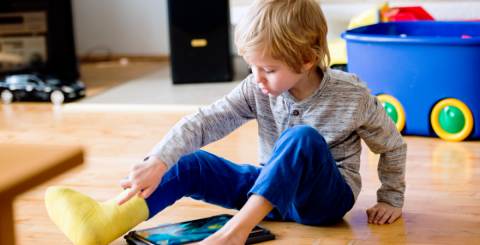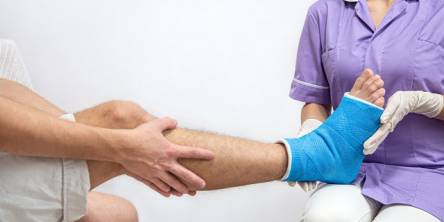Caring for a Child with a Broken Leg?

If your child has had a fracture of a bone in their leg, they will have a cast to support and protect the bone while the fracture heals. The cast may be:
- a full cast
- a partial cast held in place with bandages – this is called a back slab.
It is important to care for your child’s leg and cast correctly after you leave the hospital.
Fractures are painful. Although immobilizing the leg with a cast will help to reduce the pain, additional pain relief (e.g. paracetamol) is often needed. Give the pain relief medication regularly for the first few days, following the directions on the packet, or as directed by the doctor.
Elevate the leg
During the first one to two days, it is important for your child to rest and elevate their leg to minimize swelling. Raise your child’s leg on pillows when they are sitting or lying down. Encourage your child to move their toes frequently.
Skincare
Itching under the cast is common. Make sure your child avoids scratching inside the cast as this may damage the skin and cause infection. Do not let them push any object inside the cast. While it may be tempting to remove a back slab for brief periods, it is recommended that you leave it in place. Never cut or attempt to modify the cast or bandage. You can help relieve itch by using a hair-dryer to blow cold air into the cast (do not use warm or hot air as this can burn the skin or warp the cast). Antihistamines may be useful for reducing the itch. Talk to your local pharmacist about a suitable antihistamine medication to use.
Cast care
If your child has a plaster cast, it is important to keep the cast clean and dry. For showering or bathing, seal the cast in a plastic bag with tape or a rubber band. Never allow your child to immerse the cast in water, even if it is in a plastic bag. Even though fiberglass casts are waterproof, you need to make sure the padding underneath stays dry. If your child has a fiberglass cast, treat it as though it is a plaster cast and avoid getting it wet.
Moving about
Children are generally not allowed to put any weight on their fractured leg for walking and must keep the foot off the ground. Older children may use crutches if it is safe to do so. Young children cannot manage crutches safely but may be able to use a walking frame. A wheelchair or pusher will be needed where crutches or a walking frame are difficult, and for longer distances.
If your child is allowed to put some weight on the leg, they will need to wear a specialized shoe over their cast. This is important to protect the cast and also to reduce the risk of falling.
After the cast is removed, the skin may be dry, flaky, or even smelly. Sometimes the skin appears red with small raised bumps. The hair on the skin may appear darker and thicker than normal. Over time, the appearance of the leg will return to normal.
Wash the leg in warm soapy water. A soft flannel may be used, but avoid scrubbing the skin as this may cause it to bleed. Apply a gentle, non-perfumed moisturizing lotion after bathing. It may take several days of gentle washing to remove all of the dead skin.
Sometimes there is swelling once the cast is removed. Elevate the leg when resting. Gentle foot exercises (moving the foot up, down, and in circles) will also be helpful. If swelling is severe, limit your child’s physical activity, and rest and elevate the leg.
Because the leg muscles have not been used while the leg has been in the cast, they will be weak initially. The leg will appear thinner, and the ankle or knee may be stiff. Your child’s leg will gradually return to its normal size and strength with regular use.
Your doctor will advise whether your child has any restrictions on walking, and they may need to keep using crutches, a walking frame, or a wheelchair for some time. Your child may be anxious about putting weight through the leg. It is normal for them to limp at first, or walk with the leg held stiff or out-turned. This will improve with time, and most children will regain full use of their legs through their usual activities and play within a few months. Encouragement helps to build their confidence and enables them to return to regular activities sooner.
Similar Articles
Learn how to combine FSS and Medicaid Waiver Services for maximum benefit. FSS offers immediate family support, while Medicaid Waiver focuses on long-term individual care.
Our bodies hold a fantastic transport web under the skin. These hidden roads are our veins, which help move blood around so we can stay active and alert. They are small streams that lead back to the heart, carrying essential nutrients and oxygen.
Do you ever ask yourself why athletes and fitness enthusiasts rely on ice baths to help their sore muscles relax more?
Learn why dust extractor equipment is vital for hospitals, ensuring cleaner, healthier environments by eliminating harmful dust, allergens, and germs.
When most people hear "chin liposuction," they picture a smooth, sculpted jawline perfect for sel
There’s no doubt that healthcare has become so much more accessible thanks to digital technology, now joining the vast temple of modern conveniences. A majority of health services are provided calamity free in real time by linking patients with healthcare personnel
The healthcare landscape continues to face significant challenges, from staffing shortages and rising costs to the introduction of cutting-edge technologies. Today’s medical professionals must find innovative ways to keep pace with these changes while maintaining exceptional patient care.
Medical expert witnesses clarify complex medical issues in legal cases, influencing outcomes in malpractice, personal injury, and wrongful death claims.
Learn how collaboration between physicians and nurse practitioners enhances patient care, improves outcomes, and expands access to quality healthcare.









